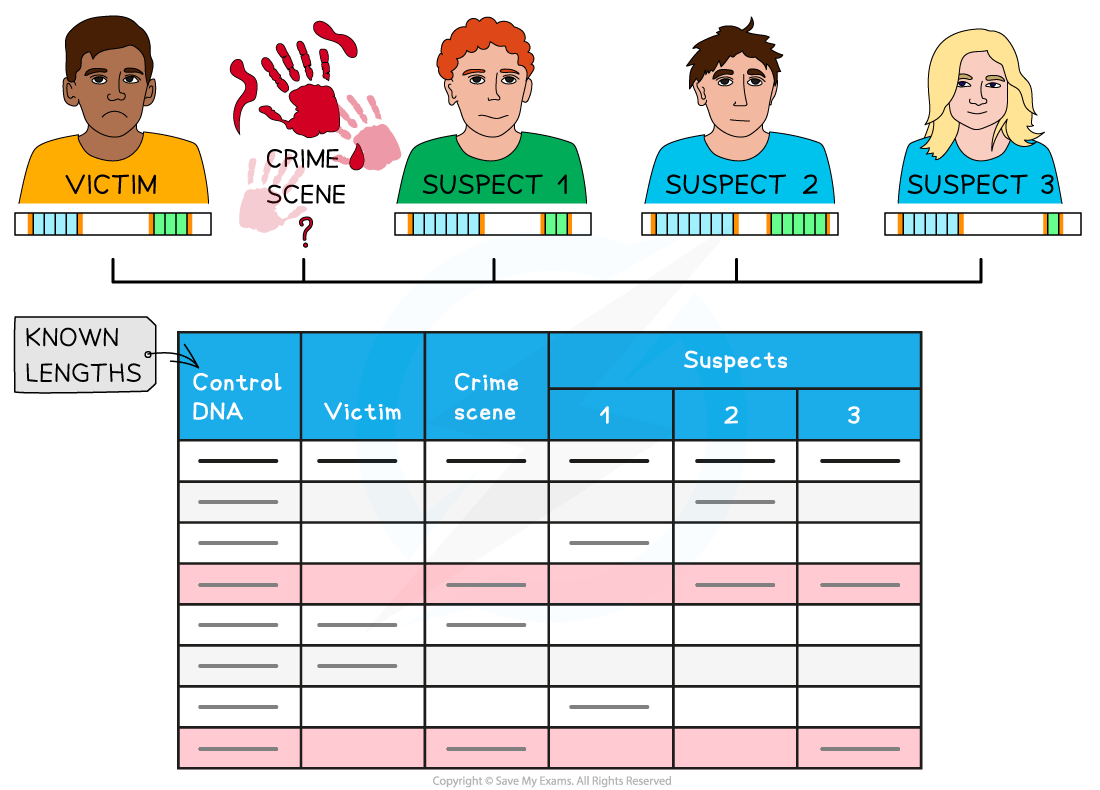Electrophoresis & PCR: Applications (DP IB Biology): Revision Note
Electrophoresis & PCR: Applications
DNA profiling
DNA profiling (also known as genetic fingerprinting) enables scientists to, e.g.:
identify suspects of a crime
identify victims
The regions of DNA analysed during DNA profiling are called VNTRs (Variable Number Tandem Repeats)
VNTRs are repeating, short, non-coding regions of DNA that can be between 20 and 50 bases long
Every person (apart from identical twins) has a combination of VNTRs that are unique to them
DNA profiling uses gel electrophoresis to separate VNTR fragments according to length to create a pattern of bands that is unique to every individual
To create a DNA profile from the DNA being tested scientists complete the following in sequence:
DNA is extracted from, e.g. the root of a hair, a spot of blood, semen or saliva
DNA is amplified using PCR to produce many copies of the fragment of DNA from very small samples
Restriction endonucleases are used to cut the amplified DNA molecules into fragments
Fragments are separated by mass using gel electrophoresis
Radioactive or fluorescent probes, that are complementary to the VNTRs, are added
X-ray imaging or UV light is used to visualise the location of the probes
These images contain patterns of bars (the DNA profile) which are then analysed and compared
Use of DNA profiling in ancestry tests
Every person inherits their DNA VNTRs from both their mother and their father
This means that DNA profiling can be used to identify an individual's parents, or other ancestors
E.g. during paternity testing
The DNA profile of the individual needs to be compared with those of the potential parents or ancestors
Patterns of bands are compared
If multiple bands are found in both the individual's and the potential ancestor's profiles, this is an indicator of ancestry, e.g. a parent would share 50% of the offspring's bands
Worked Example
Use the DNA profiles of all 6 people shown to determine who the child’s father is.

Remember, any band showing in the child's profile must be present in the mother OR father's profile, OR both. If not, that man is not the child's father.
Answer:
Step 1: look at the child's first DNA band (labelled 1)
The mother possesses this same band, so the child could have inherited that DNA from its mother. It is therefore needless to look at whether any of the men also possess that band.
Step 2: look at the child's second DNA band (labelled 2)
The mother does not possess this band, so the child must have inherited it from its father. Only B and D possess this band, so A and C are eliminated.
Step 3: look at the child's third DNA band (labelled 3)
As with band 1, the mother possesses this same band, so the child could have inherited that DNA from its mother. It is therefore needless to look at whether any of the men possess that band.
Step 4: look at the child's fourth DNA band (labelled 4)
The mother does not possess this band, so the child must have inherited it from its father. Only A, B and C possess this band, but A and C have already been eliminated. We can therefore conclude that B is the father
Step 6: look for supporting evidence from band 6
The mother does not possess this band, and the only man who possesses it is B. This reinforces the conclusion that B is the child's father
Use of DNA profiling in forensic investigations
DNA profiling has been used by forensic scientists to identify suspects
Samples of body cells or fluids, e.g. blood, saliva, hair, semen, are taken from the crime scene or victim's body
DNA is removed and profiled
The profile is compared to samples from the suspect (or criminal DNA database), victim and people with no connection to the crime (control samples)
Care must be taken to avoid contamination of the samples
DNA profiling can also be used in forensics to identify victims that are otherwise unidentifiable
DNA profiling from a crime scene can also eliminate innocent people whose DNA may happen to appear there

Examiner Tips and Tricks
In the exam you may be expected to interpret DNA profiles. For example, you could be given a few different genetic fingerprints and asked to match the victim to the crime or determine the parents of children. In these questions, you need to look for the most bands in common or a combination of parents' fingerprints that covers all the child's bands.
NOS: Reliability is enhanced by increasing the number of measurements in an experiment or test
Increasing the reliability of scientific conclusions is a very important aspect of all experimentation, but this is particularly important when evidence is being collected for use in a court of law
It is almost impossible to be 100% certain that any evidence provided is absolutely correct
In DNA profiling, reliability can be increased by increasing the number of VNTR markers being observed and compared
The more VNTRs used, the lower the chance of a false match

Unlock more, it's free!
Did this page help you?